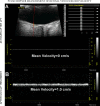Evaluation of ultrasound-assisted thrombolysis using custom liposomes in a model of retinal vein occlusion
- PMID: 22969076
- PMCID: PMC3466072
- DOI: 10.1167/iovs.12-10389
Evaluation of ultrasound-assisted thrombolysis using custom liposomes in a model of retinal vein occlusion
Abstract
Purpose: To study the potential efficacy of ultrasound (US) assisted by custom liposome (CLP) destruction as an innovative thrombolytic tool for the treatment of retinal vein occlusion (RVO).
Methods: Experimental RVO was induced in the right eyes of 40 rabbits using laser photothrombosis; the US experiment took place 48 hours later. Rabbits were randomly divided into four equal groups: US+CLP group, US+saline group, CLP+sham US group, and no treatment group. The latter three groups acted as controls. Fundus fluorescein angiography and Doppler US were used to evaluate retinal blood flow.
Results: CLP-assisted US thrombolysis resulted in restoration of flow in seven rabbits (70%). None of the control groups showed significant restoration of retinal venous blood flow.
Conclusions: US-assisted thrombolysis using liposomes resulted in a statistically significant reperfusion of retinal vessels in the rabbit experimental model of RVO. This approach might be promising in the treatment of RVO in humans. Further studies are needed to evaluate this approach in patients with RVO. Ultrasound assisted thrombolysis can be an innovative tool in management of retinal vein occlusion.
Conflict of interest statement
Disclosure:
Figures





Similar articles
-
Natural course of experimental retinal vein occlusion in rabbit; arterial occlusion following venous photothrombosis.Graefes Arch Clin Exp Ophthalmol. 2008 Oct;246(10):1429-39. doi: 10.1007/s00417-008-0878-4. Epub 2008 Jul 19. Graefes Arch Clin Exp Ophthalmol. 2008. PMID: 18642023
-
Ultrasound enhanced thrombolysis in experimental retinal vein occlusion in the rabbit.Br J Ophthalmol. 1998 Dec;82(12):1438-40. doi: 10.1136/bjo.82.12.1438. Br J Ophthalmol. 1998. PMID: 9930279 Free PMC article.
-
Acute variations in retinal vascular oxygen content in a rabbit model of retinal venous occlusion.PLoS One. 2012;7(11):e50179. doi: 10.1371/journal.pone.0050179. Epub 2012 Nov 20. PLoS One. 2012. PMID: 23185567 Free PMC article.
-
[Systemic lysis therapy in retinal vascular occlusions].Ophthalmologe. 1998 Aug;95(8):568-75. doi: 10.1007/s003470050318. Ophthalmologe. 1998. PMID: 9782735 Review. German.
-
Ischemic retinal vein occlusion: characterizing the more severe spectrum of retinal vein occlusion.Surv Ophthalmol. 2018 Nov-Dec;63(6):816-850. doi: 10.1016/j.survophthal.2018.04.005. Epub 2018 Apr 27. Surv Ophthalmol. 2018. PMID: 29705175 Review.
Cited by
-
Emerging trends in long-acting sustained drug delivery for glaucoma management.Drug Deliv Transl Res. 2025 Jun;15(6):1907-1934. doi: 10.1007/s13346-024-01779-4. Epub 2025 Jan 9. Drug Deliv Transl Res. 2025. PMID: 39786666 Free PMC article. Review.
-
Gene expression profiling in a mouse model of retinal vein occlusion induced by laser treatment reveals a predominant inflammatory and tissue damage response.PLoS One. 2018 Mar 12;13(3):e0191338. doi: 10.1371/journal.pone.0191338. eCollection 2018. PLoS One. 2018. PMID: 29529099 Free PMC article.
References
-
- Mitchell P, Smith W, Chang A. Prevalence and associations of retinal vein occlusion in Australia. The Blue Mountains Eye Study. Arch Ophthalmol. 1996;114:1243–1247 - PubMed
-
- David R, Zangwill L, Badarna M, Yassur Y. Epidemiology of retinal vein occlusion and its association with glaucoma and increased intraocular pressure. Ophthalmologica. 1988;197:69–74 - PubMed
-
- Ho JD, Tsai CY, Liou SW, Tsai RJ, Lin HC. Seasonal variations in the occurrence of retinal vein occlusion: a five-year nationwide population-based study from Taiwan. Am J Ophthalmol. 2008;145:722–728 - PubMed
-
- D'Amico DJ, Lit ES, Viola F. Lamina puncture for central retinal vein occlusion: results of a pilot trial. Arch Ophthalmol. 2006;124:972–977 - PubMed
Publication types
MeSH terms
Substances
Grants and funding
LinkOut - more resources
Full Text Sources
Miscellaneous

